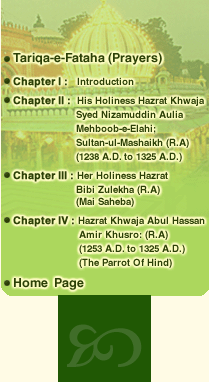(3) Path
of Sufism
Amir Khusro was very promising child.
He became a scholar of philosophy and science in short time.
At the age of twenty, he became a famous poet. He was a
man of soaring imagination. The greatness lies in his breaking
the mistrust and isolation in the then existing various
culture groups and thus paving the way for reconciliation
at the social and ideological levels. Such conciliation
and concord amongst them was a moral and intellectual demand
besides being an urgent social necessity. Khusro rose to
a high status because of his connections in political circles
and had opportunities of observing many important events
from close quarters. He was a man of learning and helped
the growth of Hindustani literary societies. His genius
unfolded itself in poetry, music and prose.
After his father’s death, he migrated
along with his mother to Delhi where he was brought up by
his maternal grand father Imadul Mulk Rawat Arz. Mir Khurd
writes that His Holiness Hazrat Syed Nizamuddin Aulia (R.A)
came to Delhi at the age of sixteen for the purpose of his
higher education in the profession of Qazi. By a strange
turn of fortune he stayed in the same locality where Amir
Khusro lived i.e. in Namak Sarai. After some time His Holiness
Hazrat Syed Nizamuddin Aulia (R.A) shifted to Rawat Arz
house on the recommendation of Hazrat Amir Khusro. He further
writes that when Amir Khusro reached his adolescence he
became "Iradat Kash" of His Holiness Hazrat Syed Nizamuddin
Aulia (R.A). Amir Khusro writes in the preface to his "Diwan"
"Wastful Hayat" that he was sixteen years old when he found
His Holiness Hazrat Syed Nizamudddin Aulia (R.A) as his
spiritual mentor, along with Mufti Moizuddin Gharifi. Both
of them guided him to the path of following the style of
Shaikh Sadi and Ispahani.
 —Hazrat Amir Khusro.
—Hazrat Amir Khusro.





